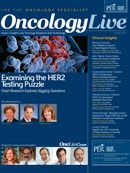Publication
Article
Oncology Live®
Dual Inhibitors Explored in Triple-Negative Tumors
Author(s):
The use of advanced gene analysis techniques in a small group of women with triple-negative metastatic breast cancer has revealed activity in two pathways found in most patients with this subtype.
Photo Courtesy © SABCS/Todd Buchanan 2011
Joyce A. O’Shaughnessy, MD
Co-Director, Breast Cancer Research Baylor Charles A. Sammons Cancer Center Texas Oncology/US Oncology Dallas, TX
The use of advanced gene analysis techniques in a small group of women with triple-negative metastatic breast cancer (MBC) has revealed activity in two pathways found in most patients with this subtype of MBC.
As a result, researchers are investigating novel therapies targeted at these pathways for the patients within a combination phase I study. Currently, there are no targeted therapies for triple-negative breast tumors, which account for an estimated 20% of breast cancers.
Specifically, the coactivation of the MAPK and PI3K/Akt pathways was demonstrated through whole-genome and transcriptome sequencing in each patient, according to Joyce A. O’Shaughnessy, MD, a lead investigator who presented the research at the San Antonio Breast Cancer Symposium in December.
Two patients were treated with combinations of agents that inhibit MEK, a critical protein in the MAPK signaling pathway, and Akt. Additional sequenced patients will also participate in the phase I study. These patients receive their treatment at the START phase I center in San Antonio, Texas.
“The study provides the scientific underpinnings for pursuing the MEK/Akt or MAPK kinase/PI3 kinase inhibitor dual strategy in triple-negative disease,” O’Shaughnessy said in an interview. “There are a number of trials either ongoing or getting started to look at this hypothesis.”
One patient in the study group had a particularly dramatic response to dual inhibition therapy. She had a rapidly proliferative cancer with a large unresectable mass in her breast that did not respond well to standard treatments, said O’Shaughnessy.
“It was impressive to see the cancer shrink as dramatically as it did, given that really nothing else had worked for her,” O’Shaughnessy said in reference to the woman’s progress with the novel therapy. “It was a very important observation and I think one that has led to a number of trials to look further at this question.”
The second patient so treated did not respond to this therapy, however.
Although the next-generation sequencing analysis is yielding important clues into the biology of triple-negative breast cancer, such techniques also demonstrate the complexities of the disease.
“There is a great deal of biologic complexity within the various subtypes of triple-negative,” said O’Shaughnessy. “Even within each individual woman’s cancer, there are multiple abnormalities, and many mutations.
“The next goal is to try and understand which of the mutations are the key metastatic ones at the time of biopsy responsible for the growth and survival of the cancer,” she said. “That could change over time under selective pressures from various therapies.”
O’Shaughnessy J, Craig DW, Kiefer J, et al. Next Generation Sequencing Reveals Co-Activating Events in the MAPK and P13K/ AKT Pathways in Metastatic Triple Negative Breast Cancers. Paper presented at: CTRC-AACR San Antonio Breast Cancer Symposium; December 8, 2011; San Antonio, TX.









